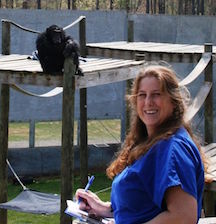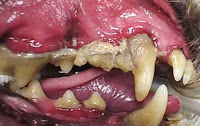Retiring Former Research Chimps
Amy Fultz, Chimp Haven
 The Director of Behavior and Research at Chimp Haven joins Animal Radio to talk about the many chimps that are now living at the sanctuary in Louisiana. Chimp Haven consists of 200 acres within a larger nature park.
The Director of Behavior and Research at Chimp Haven joins Animal Radio to talk about the many chimps that are now living at the sanctuary in Louisiana. Chimp Haven consists of 200 acres within a larger nature park.
So where did the chimps at Chimp Haven come from? Did they start out as pets and then their owners realized they could no longer handle them as they grew older? Amy Fultz tells us that they only have one chimp that was in a pet situation. Most of their chimpanzees are actually retired from biomedical research in the United States.
The chimps that were in research labs we're actually born, or lived most of their life, under fluorescent lights. Amy explains that some of the chimps were actually brought in from Africa back in the late sixties or early seventies and some were born in captivity. There are also chimps that were used in different ways and were utilized in cognitive research in a university setting as well.
They are receiving retiring additional chimpanzees on a regular basis. Once the chimps come to Chimp Haven, this will be their final home and they'll be there until the end of their lives.
Having being brought up in an environment of scientific research, it is thought that maybe some of these chimps are un-socialized and hate humans. Amy explains that every facility is different. And just like people have very different personalities, some of us are very cantankerous and others are very friendly and sociable, well these chimps are sort of the same way. She sometime thinks it may have nothing to do with how they were treated, but just their own intrinsic personality in terms of how they react to others, both other chimps and people. But certainly some of them really don't want to have much to do with humans unless they have food or goodies for them.
 Surprisingly, there are more chimpanzees that are living in sanctuaries than remain in these research facilities. This is a big deal and that number keeps going up in terms of more chimps being moved to sanctuaries.
Surprisingly, there are more chimpanzees that are living in sanctuaries than remain in these research facilities. This is a big deal and that number keeps going up in terms of more chimps being moved to sanctuaries.
Even though research on chimps in laboratories is slowly coming to a halt, Amy states that it takes awhile for the process in order to get them moved to sanctuaries. They can't just take 100 chimps and take them and pop them into the sanctuary. The chimps first have to make the trip. They also have to be very careful and keep the animal's welfare in mind the whole entire time. Plus, the trucks can only hold typically six to nine chimps at a time.
When a chimp came to Chimp Haven, they had to go through a quarantine process. Many of the chimps came in smaller groups and they had to be integrated into larger ones. So they had to introductions and give them time to acclimate. Just like if you think about it from the standpoint of a person moving to a new country for the first time, it takes a little while for them to get used to that culture and acclimate to the area and the time change, etc. It's sort of the same for the chimps. They have new caregivers. They might experience new foods for the first time. It's a different climate. So they needed to adjust and that takes a little bit of time and they had to give them time to do that before they could bring in the next shipment.
 Amy works with many chimps so we ask her is she has any favorites. She tells us her all-time favorite, who is now deceased, was Mason. She also tends to favor male chimps that have a sense of humor, are a little goofy and tend to act a little bit like the little brother who's poking you in a manner of I'm not poking you kind of a thing. She explains that they don't touch the chimps because they're so genetically similar to humans and therefore can actually share any upper respiratory viruses or stomach viruses and things like that. However, they do use long handled spoons to tickle them and play with them. She tells us that a lot of people don't know that chimps actually do laugh.
Amy works with many chimps so we ask her is she has any favorites. She tells us her all-time favorite, who is now deceased, was Mason. She also tends to favor male chimps that have a sense of humor, are a little goofy and tend to act a little bit like the little brother who's poking you in a manner of I'm not poking you kind of a thing. She explains that they don't touch the chimps because they're so genetically similar to humans and therefore can actually share any upper respiratory viruses or stomach viruses and things like that. However, they do use long handled spoons to tickle them and play with them. She tells us that a lot of people don't know that chimps actually do laugh.
So what is a typical day in the life of chimps at Chimp Haven? Do they play with any electronics or iPads? Amy explains that what's most important to a chimpanzee is another chimp and being social with the other chimpanzees. However, when they have what are called interaction days with their caregivers, they might bring an iPad to show them a game, but that's a special kind of a treat. The chimps spend most of their time in their outdoor enclosures in the beautiful Louisiana weather and in the forested areas of the sanctuary just being chimps and living the chimp life.
Visit Website
Rescuing The Dogs of China
Jeffrey Beri, No Dogs Left Behind
 Jeffrey Beri founded the global animal rescue No Dogs Left Behind. He was formerly in China, where he rescued thousands of dogs from a horrific life and ultimate slaughter. He reports that fortunately the Chinese are changing their view on pets.
Jeffrey Beri founded the global animal rescue No Dogs Left Behind. He was formerly in China, where he rescued thousands of dogs from a horrific life and ultimate slaughter. He reports that fortunately the Chinese are changing their view on pets.
We fight the good fight right here on our own soil in the US for our companion animals. We're doing everything we can to help them find good situations, find homes, take them out of bad situations and educate people so that our pets may live a longer, healthier, happier life. But there are people that have gone beyond our soil to places like China.
No Dogs Left Behind is an emergency response unit that goes beyond borders, because as far as Jeffrey is concerned, rescue has no borders. It doesn't matter where it is that a dog's in need. They go there. Jeffrey was formerly in China. He tells us they assisted in a historical rescue of 1,300 dogs that were in desperate need of care and originally headed for the dog meat trade.
Jeffrey explains that there's a very serious matter in China and a dog's life there is very difficult, especially the larger breed dogs. This is because some of the larger breed dogs aren't even legal in some of the geographical locations. He tried to educate the Chinese people on adoption programs and not buying dogs that have been bred, but instead to adopt dogs that are from rescues. Most of the dogs in rescues have been stolen and they are stolen from homes and even off the streets.
In China, they have these dogs that are collected from all over the place and then they're beaten and tortured and then ultimately eaten. The Chinese myth is that they believe that when it's the summer solace, eating these dogs will bring good health. They also believe that they'll warm their bodies up.
This is the 21st century and change is in order. No Dogs Left Behind believes in the sustainable component. They believe that it is critical to get these dogs to safety.
So what happens to these rescues? Are they adopted in China or are they all brought back to the United States? Jeffrey says both. They work on educational awareness programs to educate the people of China to adopt versus buying dogs that have been bred. But sometimes they need to take some of the dogs back to America because they have no chance in China.
 No Dogs Left Behind has shut down slaughterhouses and they've gone to truck interceptions where the trucks were heading to Yulin. Brave activists intercepted trucks and then brought the dogs to specific locations. When these dogs got to these locations, they were virtually dying from distemper, parvo, exposure, extreme trauma of their bones from being exposed and being stuffed in these cages. His team went in and they implement five to ten tier treatment protocols where they separated the dogs and they educated the Chinese activists and shelters on how to enforce a western treatment protocol. And when they said that 80-percent would die, 80-percent have lived. So that's testament to No Dogs Left Behind in their treatment protocols.
No Dogs Left Behind has shut down slaughterhouses and they've gone to truck interceptions where the trucks were heading to Yulin. Brave activists intercepted trucks and then brought the dogs to specific locations. When these dogs got to these locations, they were virtually dying from distemper, parvo, exposure, extreme trauma of their bones from being exposed and being stuffed in these cages. His team went in and they implement five to ten tier treatment protocols where they separated the dogs and they educated the Chinese activists and shelters on how to enforce a western treatment protocol. And when they said that 80-percent would die, 80-percent have lived. So that's testament to No Dogs Left Behind in their treatment protocols.
Jeffrey's been doing this for many years, so does he see the dog meat trade slowing down at all? Yes, he says he sees a very big change in the movement. And again, one of the main things is an education awareness program.
They have many students that come to No Dogs Left Behind to learn more about the dogs and how to maintain a lifestyle with a dog. He believes that the educational awareness program is key and fundamental to the change.
So does Jeffrey also see a paradigm shift in the way the Chinese are thinking about their animals especially companion animals? Again, yes he does. He says with conviction that he thinks that change is in order and he's seeing this happen literally in front of his eyes. In the past, dogs were always running free and now he has seen many people walking their dogs on leashes and holding their dogs in their arms and taking much needed care of them.
To fund No Dogs Left Behind, Jeffrey states that they have a social media outreach and they are very blessed by fabulous donors who have contributed to the cause of ending the dog meat trade.
Visit Website
The Dangers of Doggie Dragon Breath - Dr. Debbie
 Does your dog's breath cause you to gag and turn away? Are your pet's kisses unwelcome due to fetid breath? Many dog owners recognize that distinctive smell which is often accepted as a condition of dog ownership. But stinky dog breath, while common, is actually a symptom of illness and should not be ignored. Doggie dragon breath, just like a blinking traffic light, is a sign of danger ahead. Don't ignore dog breath for what it is - an indicator of oral infection that if left unchecked will impact your dog's health and shorten his lifespan.
Does your dog's breath cause you to gag and turn away? Are your pet's kisses unwelcome due to fetid breath? Many dog owners recognize that distinctive smell which is often accepted as a condition of dog ownership. But stinky dog breath, while common, is actually a symptom of illness and should not be ignored. Doggie dragon breath, just like a blinking traffic light, is a sign of danger ahead. Don't ignore dog breath for what it is - an indicator of oral infection that if left unchecked will impact your dog's health and shorten his lifespan.
What's the big deal about bad breath? It's more than just the smell. Bad breath, also referred to as halitosis, arises from plaque and oral bacteria. Periodontal disease progresses as plaque accumulates, mineralizes into tartar, and inflammation causes destruction of the supportive tissues around the teeth. Dogs don't simply get cavities, rather they will lose their teeth as connective attachments deteriorate. Untreated dental infections jeopardize the health of nearby teeth and may lead to osteomyelitis - infection in the bone. And with time, untreated periodontal disease showers the bloodstream with bacterial products leading to other diseases such as liver, kidney and heart disease.
Fight Halitosis
The best way to control periodontal disease is to assume an offensive attack. Monitor your pet's oral health by flipping up your dog's lip to discover what is lurking underneath. Look for red inflamed gums, yellow or brown accumulation on the teeth, tooth discoloration, or bad breath. Any symptoms of periodontal disease should be addressed with your veterinarian. Have your pet's teeth cleaned regularly at the veterinary office and follow up with home dental care including daily brushing.
These professional veterinary cleanings are important to safely remove mineralized tartar, clean under the gum line, permit a thorough oral exam and take x-rays. Veterinary dental x-rays are an essential tool in detecting problems and have been shown to identify oral disease in 28-percent of dogs and 42-percent of cats that have an outwardly normal mouth.
Don't fall into the hype about herbal spray-on products or 'awake' dental procedures - these only offer a cosmetic improvement in visible tartar, which only covers a small part of the tooth. These methods, often incorrectly touted as a safe alternative to professional cleanings, can't address the 60-percent of a dog's tooth which lies under the gum line - exactly where periodontal disease brews and does its damage.
 Once you identify that nasty doggie breath, you can be certain some degree of periodontal disease is present and dental intervention is needed. Statistics show that by 3 years of age 80-percent of dogs and cats already have periodontal disease. Don't forget that small and toy breeds of dog have accelerated dental problems diagnosed as young as 1 to 2 years of age.
Once you identify that nasty doggie breath, you can be certain some degree of periodontal disease is present and dental intervention is needed. Statistics show that by 3 years of age 80-percent of dogs and cats already have periodontal disease. Don't forget that small and toy breeds of dog have accelerated dental problems diagnosed as young as 1 to 2 years of age.
Think prevention - have your dog's teeth cleaned and embrace home dental care steps. And the next time you find yourself in a cloud of canine halitosis, you won't turn the other way - you'll grab that toothbrush.
Featured veterinarian known as "Dr. Debbie" on national pet radio program, Animal Radio. Ebook author of "Yorkshire Terriers: How to Be Your Dog's Best Friend"; "Pugs: How to Be Your Dog's Best Friend"; "Mini Schnauzers: How to Be Your Dog's Best Friend"; and "Shih Tzu: How to Be Your Dog's Best Friend." Dr. Debbie's books.
Visit Website
Animal Radio News - Lori Brooks
 Veterinarians Face Opioid Shortage
Veterinarians Face Opioid Shortage
All of the attempts to fight the opioid epidemic among humans amid overdose deaths attributed to the addictive drugs, lead to restrictions that trickled down to problems affecting pets. An opioid shortage forced vet clinics and animal hospitals to use less potent drugs when performing surgeries on pets, which some say changed how they got animals under anesthesia and kept them under so they didn't feel the pain. Because of this, a spay/neuter clinic in Oregon restricted how many large female dogs were being spayed. It's expected that the shortage of sedatives for pets will hopefully begin to subside.
Stop Parasites From Spreading
A study by a veterinarian in Los Angeles found that one out of every eight pets in Southern California tested positive for internal parasites, which can plague a pet's insides causing health issues. Remember, if you don't pick up the poop after your dog goes to the bathroom, you could be putting other pets at risk of getting parasites. This is because other dogs may sniff it or walk through the poop and can then digest any worms. In dogs, the occurrence of hookworms has remained stable over the last several years. Dogs can even catch hookworms by playing in contaminated soil. Common symptoms of a dog that has worms include a poor appetite or the lining of a dog's nostrils, ears and gums may be pale in color. They may also have diarrhea and may even vomit. In cats, tapeworms are the most prominent parasite, but roundworms and whipworms can also affect housecats. Fleas can carry parasites to housecats as well. And remember; don't let your pets near dried poop from wildlife either.
 What TV Shows Do You Watch With Your Pet?
What TV Shows Do You Watch With Your Pet?
Netflix did a survey recently questioning pet lovers about how and what they like to watch with their furry best friends. Here's what they found out - when it comes to watching TV, most people (71-percent) find pets to be the best binge partner. But it doesn't stop there, 27-percent have even talked to their pet about the show or movie they were watching. According to the survey, dog owners are more likely to choose action shows like Narcos and Marvel's Daredevil.
Think About Your Pets When Buying That Tech Gadget
You should consider your pet before going out and buying the newest tech gadget for your home. Tech expert Kim Komando says every piece of technology we put into our homes could very easily emit a sound that cannot be heard by humans but comes in loud and clear for pets. That's not to say pets are suffering because of our gadgets, but that the possibility exists and it is something you may want to consider. Komando says there's a reason dog whistles exist and why the vacuum cleaner is one of dogs greatest rivals, because dogs hear better than humans. In scientific terms, humans can hear sounds up to about 20,000 Hz, while dogs can hear sounds up to 45,000 Hz and cats 64,000 Hz. That means there are frequencies undetectable to us but very noticeable and even hurtful to animals. Unfortunately for our pets, manufacturers design things for humans, not for them. A number of studies were done to try and determine what kind of impact noise has on animals. One done in 2005 by Dr. Jeremy G. Turner of the Southern Illinois University School of Medicine Department of Pharmacology, concluded that it can lead to issues with animals' hearts, sleep and endocrine cycles while making them more susceptible to seizures. Lights can also be a problem, because animals see the world differently than humans. Flickering lights can be problematic, which is bad news for pets whose owners use LED bulbs in their home. Some LED lights flicker more than others, though the speed at which they do so isn't really noticed by humans. For us, about 24 Hz or "flickers" per second will look steady. Komando says that is similar to frames-per-second with video, which is more than enough for us to feel like it looks right. Dogs, however, are sensitive up to 80 Hz or flickers per second.
 Listen to the entire Podcast of this show (#1168)
Listen to the entire Podcast of this show (#1168)





